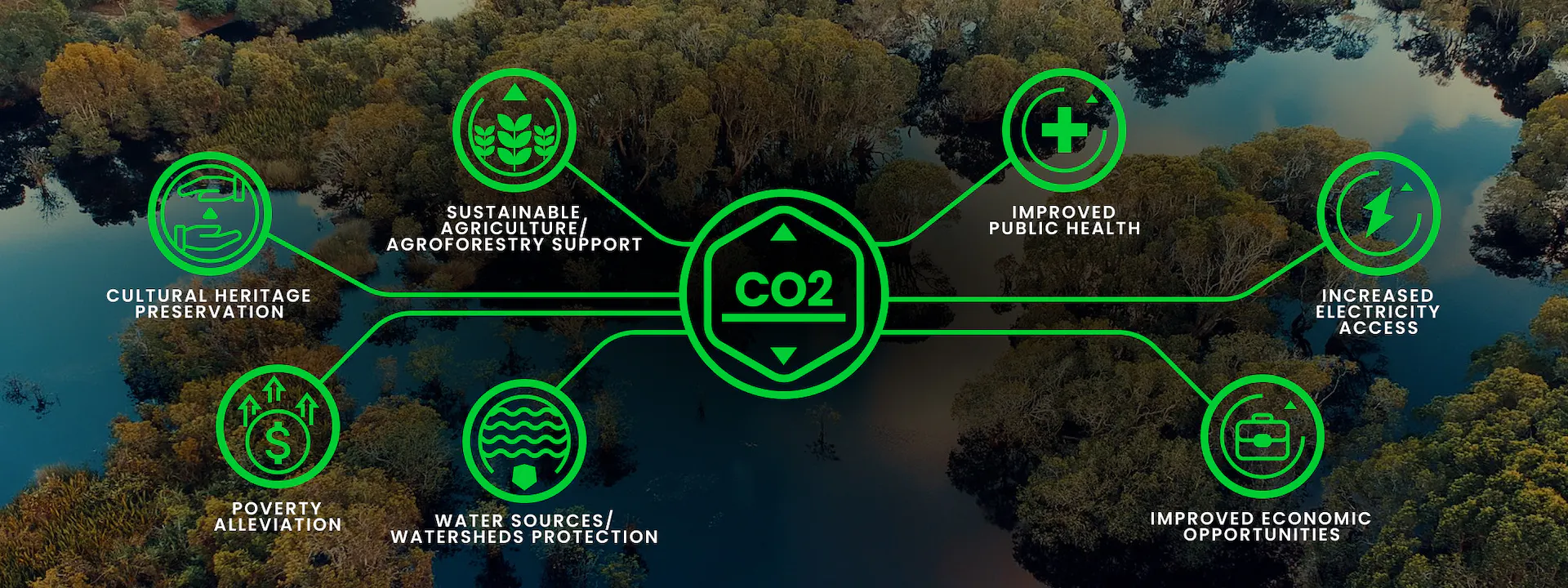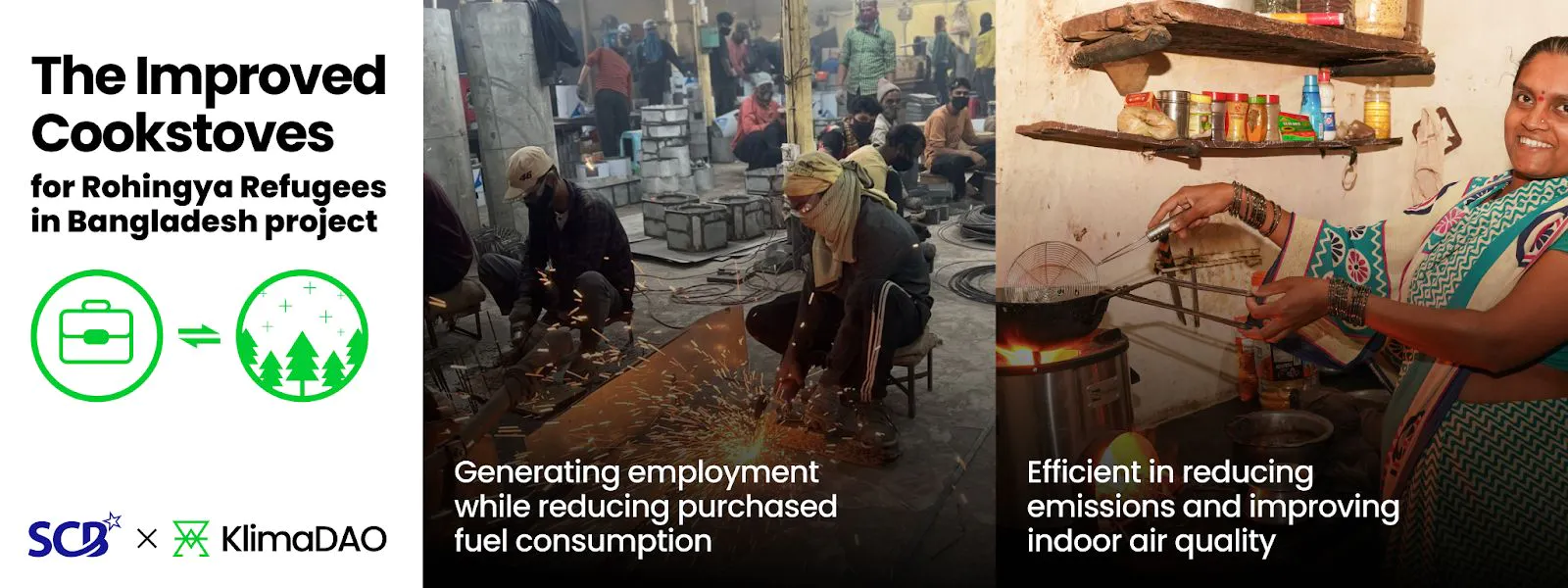
A carbon credit is a certificate that represents one metric ton of carbon dioxide equivalent that has been reduced, avoided, or removed from the atmosphere through a certified carbon reduction project. Using these fundamental building blocks as its units of account, the Voluntary Carbon Market (VCM) is a powerful tool for reducing greenhouse gas emissions (GHGs).
However, beyond their role in the fight against climate change, the carbon reduction projects that produce the credits also provide additional co-benefits to the people who live and work in the areas in which these endeavors take place.
A co-benefit is an additional positive impact that a project has beyond its primary purpose. Some of the co-benefits of carbon reduction projects include:
Improved public health through reduced air pollution;
Increased access to electricity in remote or rural areas;
Support for sustainable agriculture or agroforestry;
Protection of water sources and watersheds;
Preservation of cultural heritage sites and practices;
Creation of local jobs and economic opportunities; and
Poverty alleviation.

For example, a project that involves reforestation can also provide jobs for local communities and protect habitats for endangered species, thus improving people’s livelihoods and protecting biodiversity in addition to reducing GHGs. By supporting carbon reduction projects, individuals and businesses can therefore contribute to:
mitigating climate change globally;
protecting a specific environment; and
alleviating poverty
The climate change–poverty nexus
Because low- and middle-income countries (LMICs) and people living in poverty are more reliant on natural resources for their survival, the negative impacts of climate change are more severe for them. Around 75% of people living in poverty in rural areas depend on natural resources such as forests, lakes, and oceans for their livelihoods, meaning they are particularly vulnerable to bushfires, droughts, cyclones, and other disasters caused by climate change.
Moreover, climate change can exacerbate existing inequalities by increasing the cost of food, water, and energy. This is particularly true in LMICs, as such countries typically lack the fiscal space to deploy the resources needed to adapt to changing weather patterns and extreme weather events.
By supporting carbon reduction projects with poverty-reducing co-benefits, buyers of carbon credits can help alleviate these hardships. In addition, carbon credits themselves can provide a new source of income for local communities. In many cases, carbon reduction projects offer payments to landowners or project participants for their contributions to the project. This can provide a stable and predictable source of income.
Gold Standard: prioritizing co-benefits in carbon reduction projects

Of the main carbon registries, Gold Standard has particularly focused on crediting methodologies that prioritize co-benefits.
Gold Standard was established in 2003 by environmental NGOs including WWF and is a widely recognized and respected standard in the VCM. It has developed rigorous methodologies for assessing the environmental and social impacts of carbon reduction projects, ensuring they have clear co-benefits. To receive certification from Gold Standard, projects must demonstrate measurable, verifiable, and additional emission reductions as well as delivering benefits to local communities in areas such as sustainable livelihoods, health, and education.
As such, Gold Standard focuses on projects that can provably advance specific Sustainable Development Goals (SDGs), such as:
SDG 1: No Poverty;
SDG 3: Good Health and Well-being;
SDG 6: Clean Water; and
SDG 7: Affordable and Clean Energy.
Co-benefits in action

An example of a Gold Standard-certified project that prioritizes co-benefits is the Clean Water Access project developed by Water Health India (WHIN). In order to provide clean water to 5 million individuals in rural Indian communities, 400 Water Health Centers (WHCs) have been built, each serving a community ranging from 5,000 to 20,000 people.
These centers are modular structures that house water purification equipment to treat locally available water. Each WHC produces safe water for a nominal fee that is determined in partnership with communities. The co-benefits of WHIN’s project include:
Increased access to clean, affordable water;
Consumer households being nine times less likely to contract waterborne illnesses;
Overall community health improvement and the positive social implications of this; and
The provision of jobs for young people and women.
Other examples include the Planting Biodiverse Forests in Panama project, which as well as improving biodiversity and ecosystem resilience provides decent employment and knowledge transfer around the use of sustainable and innovative forest management technologies, GIS, and monitoring systems. A project supporting the use of bio-slurry as a fertilizer through the Indonesia Domestic Biogas Programme offers a further example.
KlimaDAO’s commitment to co-benefits

By design, KlimaDAO's open infrastructure welcomes carbon reduction projects of all kinds in its wider ecosystem–including those with verifiable co-benefits. Support for SCB’s Improved Cookstoves for Rohingya Refugees in Bangladesh project, for example, was ratified in KIP-32 via the community governance process.
This is a forward carbon project that aims to replace traditional wood-fuel cookstoves with high-efficiency biomass-fired improved cookstoves, reducing emissions and improving indoor air quality. Given that Gold Standard has by far the most advanced cookstove certification methodology, unsurprisingly SCB is seeking Gold Standard certification for this project.
Around 81% of Bangladesh's population uses solid fuel for cooking, with 39.5% using wood as their primary fuel. Some 82% of households rely on polluting fuels and cooking technology, with around 135.2 million people lacking access to clean cooking. The cookstoves distributed through this project are designed to be more efficient in transferring heat and reducing emissions compared to traditional stoves.
By disseminating the improved cookstoves and educating beneficiaries on their use, the project not only reduces emissions but also increases access to basic services and new technology while tackling poverty by reducing purchased fuel consumption. The project also generates employment for marketing, sales, distribution, and technical employees, thus aiding economic growth through the provision of decent work.
Conclusion
KlimaDAO shares Gold Standard’s commitment to prioritizing carbon reduction projects that also advance specific SDGs. We firmly believe that standards of living can be raised during the transition to a low-carbon and Net Zero future, and are underlining that commitment in the types of projects our community supports.
The Digital Carbon Market, while building on the foundations of the traditional VCM, has the possibility to revolutionize the way carbon credits are generated and traded. Through the strategic deployment of blockchain technology to enhance market mechanisms, transparency, accountability, and efficiency are improved. The DCM also has the potential to democratize the market, opening it up to a diverse range of stakeholders and investors who were previously excluded.
It is fitting, then, that KlimaDAO and the DCM align with Gold Standard’s approach in prioritizing carbon reduction projects that provide co-benefits beyond emission reductions, improving the lives of people in LMICs and protecting the environments on which they rely, as well as reducing GHG emissions on the global level.
Disclaimer: The information provided in this blog post pertaining to KlimaDAO (“KlimaDAO”), its crypto-assets, business assets, strategy, and operations, is for general informational purposes only and is not a formal offer to sell or a solicitation of an offer to buy any securities, options, futures, or other derivatives related to securities in any jurisdiction and its content is not prescribed by securities laws. Information contained in this blog post should not be relied upon as advice to buy or sell or hold such securities or as an offer to sell such securities. This blog post does not take into account nor does it provide any tax, legal or investment advice or opinion regarding the specific investment objectives or financial situation of any person. KlimaDAO and its agents, advisors, directors, officers, employees and shareholders make no representation or warranties, expressed or implied, as to the accuracy of such information and KlimaDAO expressly disclaims any and all liability that may be based on such information or errors or omissions thereof. KlimaDAO reserves the right to amend or replace the information contained herein, in part or entirely, at any time, and undertakes no obligation to provide the recipient with access to the amended information or to notify the recipient thereof. The information contained in this blog post supersedes any prior blog post or conversation concerning the same, similar or related information. Any information, representations or statements not contained herein shall not be relied upon for any purpose. Neither KlimaDAO nor any of its representatives shall have any liability whatsoever, under contract, tort, trust or otherwise, to you or any person resulting from the use of the information in this blog post by you or any of your representatives or for omissions from the information in this blog post. Additionally, KlimaDAO undertakes no obligation to comment on the expectations of, or statements made by, third parties in respect of the matters discussed in this blog post.